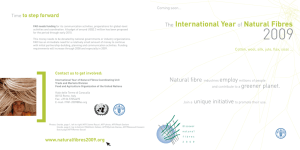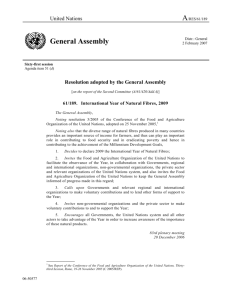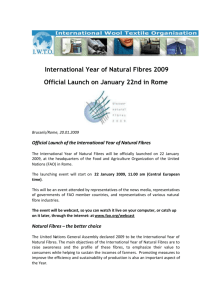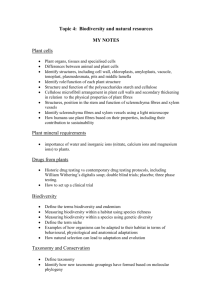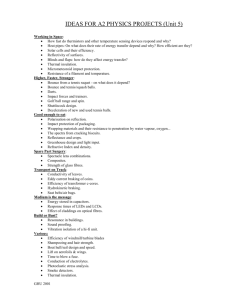Jute Fibre Production Thousand tonnes
advertisement
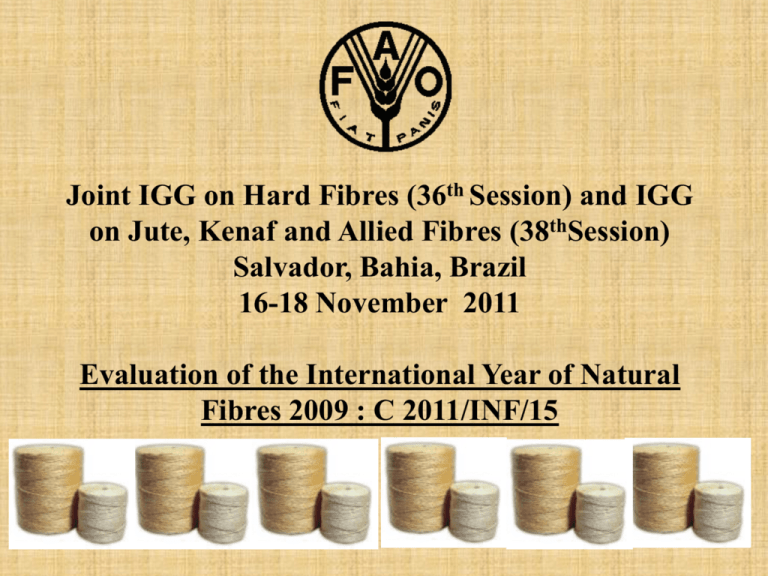
Joint IGG on Hard Fibres (36th Session) and IGG on Jute, Kenaf and Allied Fibres (38thSession) Salvador, Bahia, Brazil 16-18 November 2011 Evaluation of the International Year of Natural Fibres 2009 : C 2011/INF/15 Evaluation of the International Year of Natural Fibres 2009 : C 2011/INF/15 • The United Nations General Assembly proclaimed 2009 to be the International Year of Natural Fibres (IYNF) as recommended by FAO Conference Resolution 3/2005. In doing so, it noted that the diverse range of natural fibres produced in many countries provided an important source of income for farmers, and hence contributed to the achievement of the Millennium Development Goals through eradicating poverty and improving food security. Evaluation of the International Year of Natural Fibres 2009 : C 2011/INF/15 • As the lead agency, FAO required at least USD 2 million to effectively implement the IYNF. Unfortunately, the exceptionally difficult economic climate of 2009 affected potential inflows of donor funds and commercial sponsorship. Nevertheless, FAO endeavoured to make progress, devoting approximately USD 120 000 from its own budget, bolstered by external donations amounting to around USD 57 000 (USD 44 000 from the Common Fund for Commodities; USD 8 000 from the Government of New Zealand; and USD 5 000 from the International Jute Study Group). In spite of such small outlays, FAO’s achievements were nonetheless considerable. Evaluation of the International Year of Natural Fibres 2009 : C 2011/INF/15 • Key to celebrating the year and promoting its objectives were the host of events that took place outside of Rome. Well over 150 conferences, workshops, exhibitions, seminars, fairs and festivals were organised in 50 countries. These decentralised initiatives were the key strength in raising awareness about natural fibres and the sheer number and geographical diversity of these events underlined the importance of natural fibres around the world. Evaluation of the International Year of Natural Fibres 2009 : C 2011/INF/15 • Recognizing that the objectives of the Year could not be realized in the space of 12 months, FAO along with key stakeholders committed to sustaining momentum beyond 2009. The transition underway of the centralized effort to representative organizations of natural fibre industries will likely secure sustainable success in relation to IYNF objectives. For example, as the Organization has not been able to consistently maintain the IYNF website due to resource constraints, the International Cotton Advisory Committee (ICAC) has agreed to host the website in such a way that each natural fibre can manage their own information themselves. In addition, the Discover Natural Fibres Initiative (DNFI) was founded in early 2010, comprising an alliance of international natural fibre associations with emphasis on textiles. Evaluation of the International Year of Natural Fibres 2009 : C 2011/INF/15 • FAO, in its capacity as the lead agency in planning and coordinating activities, has endeavoured to ensure that progress in realizing the objectives of the Year continues. A major development in support of this initiative has been the design of the project funded by Germany that is currently being implemented by FAO, and whereby all of the IYNF objectives are being addressed. The project is worth USD 3.15 million and is titled: “Unlocking Commercial Fibre Potential in Developing Countries: strengthening global value chains for rural development, poverty alleviation and the environment”. Evaluation of the International Year of Natural Fibres 2009 : C 2011/INF/15 : Conclusion • Item 17: Evaluation of the International Year of Natural Fibres 2009 (C 2011/INF/15) • • The Conference endorsed the report of the Evaluation of the International Year of Natural Fibres 2009 (IYNF), and took note of comments made during the agenda item. • It noted the transition underway of the centralized effort to representative organizations of natural fibre industries which should secure sustainable success in relation to IYNF objectives. END
